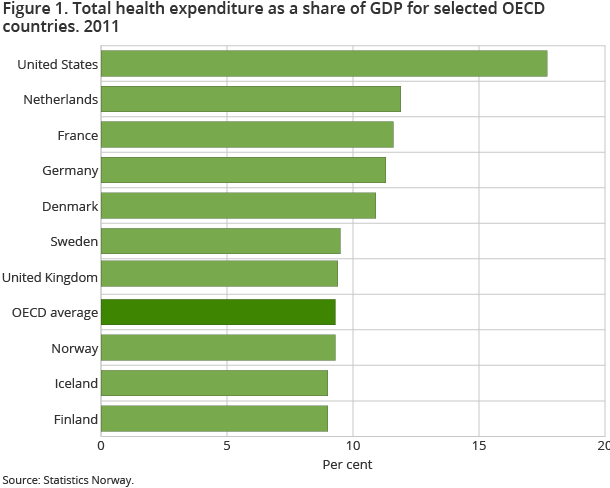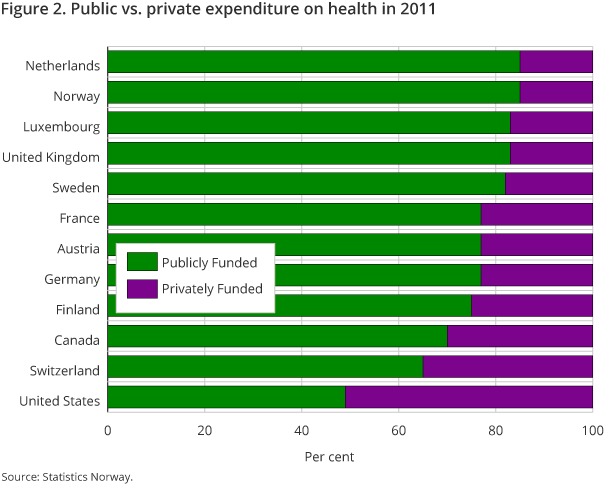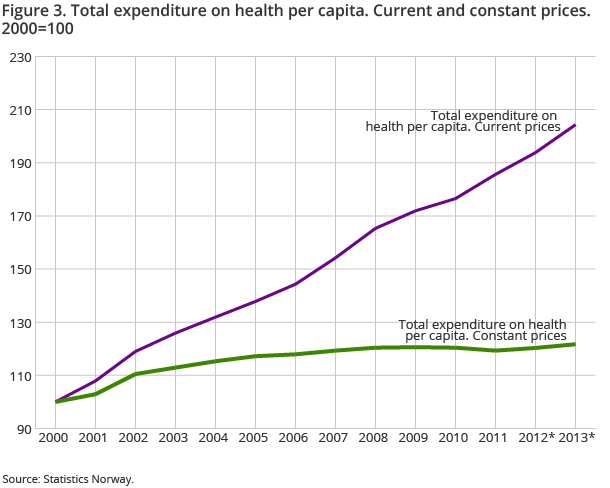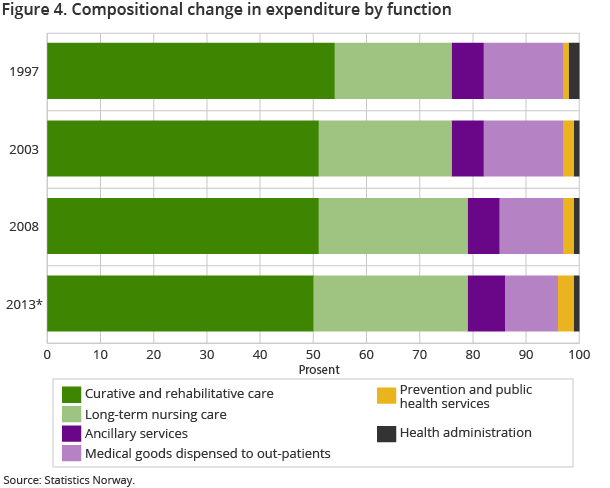Content
Published:
This is an archived release.
NOK 57 000 spent on health care per capita
Total health expenditure is estimated at NOK 288 billion in 2013. This represents 9.6 per cent of GDP. Measured in volume, health spending has increased by approximately 20 per cent over the last decade.
| 2009 | 2010 | 2011 | 2012 | 2013 | |
|---|---|---|---|---|---|
| 1Estimates for 2012 and 2013 are preliminary | |||||
| Total health expenditure. NOK million | 230 473 | 239 730 | 255 366 | 270 052 | 288 283 |
| Volume growth from previous year | 1.4 | 1.1 | 0.3 | 2.2 | 2.4 |
| Capital formation in health care institutions. NOK million | 10 105 | 8 945 | 9 542 | 11 385 | 15 371 |
| Current expenditure on health. NOK million | 220 368 | 230 785 | 245 824 | 258 667 | 272 911 |
| Total health expenditure. Per cent of GDP | 9.7 | 9.4 | 9.3 | 9.3 | 9.6 |
| Total health expenditure. Per cent of GDP Mainland Norway | 12.3 | 12.1 | 12.3 | 12.3 | 12.4 |
| Total health expenditure per inhabitant. NOK | 47 730 | 49 032 | 51 557 | 53 811 | 56 747 |




Preliminary figures from the Health accounts show that total health expenditures amounted to NOK 288 billion in 2013. This corresponds to approximately NOK 56 700 per capita. Measured at constant 2005 prices, the figures show an increase of about 2.4 per cent from 2012, and over 20 per cent from 2003.
Health spending has increased, but so has the population. The growth in health spending per capita has therefore been somewhat more moderate than the growth in total health expenditure. Health expenditure per capita has increased from about NOK 36 900 in 2003 to NOK 39 800 million in 2013, measured at constant 2005 prices. This corresponds to an average annual increase of 0.8 per cent.
The number of man-years worked and employment associated with the production of health care have increased in recent years. This is unsurprising since labour costs constitute a large share of the costs associated with the production of health services. The number of man-years worked and total health expenditure will therefore correlate to a large extent. Total man-years worked were approximately 283 000 in 2011. This is approximately 32 000 man-years more than in 2006 and 59 000 more than 10 years earlier.
Norway's health spending at the same level as the rest of the OECD countries
Health expenditure as a share of GDP is often used in international comparisons of health spending. In 2013, health spending accounted for 9.6 per cent of GDP. This is a slight increase from 2011 and 2012, when the share was 9.3 per cent. By comparison, the average health spending for OECD countries was 9.3 per cent in 2011, which are the latest figures available from OECD. Thus, the Norwegian health expenditure as a share of GDP was on a par with the OECD average in 2011.
High share of public financing in Norway
The share of public financing differs widely among OECD countries, and Norway is one of the countries with the highest share. Only the Netherlands has a higher proportion of public financing than Norway. In Norway, the share of public financing has increased from 81.3 per cent in 1997 to 85.5 per cent in 2013.
Compositional changes in expenditure by function
Of the total health expenditure of NOK 288 billion, current health spending constituted NOK 273 billion. The remaining NOK 15 billion was investments. The investments have increased every year since 2010, partly due to the construction of new hospitals, and investments related to the coordination reform introduced in January 2012.
The allocation of health spending by function has remained relatively stable over the last decade. From 2003 to 2013, the share of spending on long-term nursing care increased by about 4 percentage points, while the proportion of medical goods dispensed to out-patients has been reduced accordingly.
Services of curative and rehabilitative care account for the largest share of the total health expenditure. These services accounted for about 48 per cent of the total health spending in 2013. Services of long-term nursing care make up the next largest share. In 2013, these services accounted for 27.5 per cent of total health spending.
What total expenditure on health includesOpen and readClose
Total expenditure on health measures the final consumption of health care goods and services (i.e. current health expenditures) in addition to capital investment in health care infrastructure. This includes spending by public and private sources (including households) on medical goods and services, public health, preventive health care programmes and administration. Health expenditure also includes expenditure on health care and social services. According to international guidelines, only expenditure for health care and social services that are health related should be included in the health accounts.
Volume growth in national figures differs from OECD estimateOpen and readClose
The volume growth in our national figures may differ from the growth estimated by the OECD in the publication “Health at a Glance”. This is because the OECD uses a method where the total health spending figures are deflated using an economy-wide GDP deflator. In the Norwegian figures, the volume growth is calculated according to the national accounts method, meaning that many different but relevant price indices are used or that the volume changes are observed directly. An example of the latter is the hospitals’ DRG system, which can have information on the volume of hospital services.
Contact
-
Eirik Larsen Lindstrøm
E-mail: eirik.lindstrom@ssb.no
tel.: (+47) 46 78 22 92
